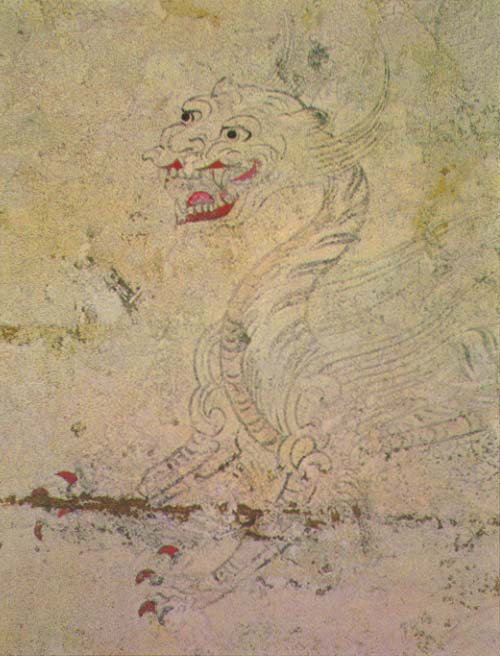White Tiger (China) on:
[Wikipedia]
[Google]
[Amazon]
The White Tiger ( Chinese: 白虎, 
Pinyin
Hanyu Pinyin (), often shortened to just pinyin, is the official romanization system for Standard Chinese, Standard Mandarin Chinese in China, and to some extent, in Singapore and Malaysia. It is often used to teach Mandarin, normally writte ...
: ''Báihǔ''), known in Chinese as Baihu, is one of the Four Symbols
The Four Symbols (, literally meaning "four images"), are four mythological creatures appearing among the Chinese constellations along the ecliptic, and viewed as the guardians of the four cardinal directions. These four creatures are also ref ...
of the Chinese constellations. It is sometimes called the White Tiger of the West (). It represents the west in terms of direction and the autumn season. It is known as Byakko in Japanese, Baekho in Korean, and Bạch Hổ in Vietnamese.
Seven Mansions
As with the other three Symbols, there are seven astrological "Mansions" (positions of theMoon
The Moon is Earth's only natural satellite. It is the fifth largest satellite in the Solar System and the largest and most massive relative to its parent planet, with a diameter about one-quarter that of Earth (comparable to the width of ...
) within the White Tiger. The names and determinative stars are:
Origin
InChinese culture
Chinese culture () is one of the world's oldest cultures, originating thousands of years ago. The culture prevails across a large geographical region in East Asia and is extremely diverse and varying, with customs and traditions varying grea ...
, the tiger
The tiger (''Panthera tigris'') is the largest living cat species and a member of the genus ''Panthera''. It is most recognisable for its dark vertical stripes on orange fur with a white underside. An apex predator, it primarily preys on ...
is the king of the beasts and has been presented with a () on his forehead for centuries. According to legend, the tiger's tail would turn white when it reached the age of 500 years. In this way, the white tiger
The white tiger or bleached tiger is a leucistic pigmentation variant of the Mainland tiger. It is reported in the wild from time to time in the Indian states of Madhya Pradesh, Assam, West Bengal, Bihar, Odisha, in the Sunderbans region and ...
became a kind of mythological creature. It was said that the white tiger would only appear when the emperor
An emperor (from la, imperator, via fro, empereor) is a monarch, and usually the sovereignty, sovereign ruler of an empire or another type of imperial realm. Empress, the female equivalent, may indicate an emperor's wife (empress consort), ...
ruled with absolute virtue or if there was peace throughout the world. Because the color white
White is the lightest color and is achromatic (having no hue). It is the color of objects such as snow, chalk, and milk, and is the opposite of black. White objects fully reflect and scatter all the visible wavelengths of light. White o ...
of the Wu Xing Wuxing may refer to:
Places in China Counties and districts
*Huzhou, formerly Wuxing County, Zhejiang, China
*Wuxing District (吴兴区), central district of Huzhou
Subdistricts (五星街道)
*Wuxing Subdistrict, Mudanjiang, in Dong'an District ...
theory also represents the west, the White Tiger became a mythological Guardian Of The West.
Worship
During the Han Dynasty, there was the old custom of worshipping the White Tiger God on the 14th of the first lunar month in Huiji, Zhejiang, at Baihu Temple, one of the four Weiyang Temples. According to textual research, the worship of the white tiger appears in the ancient Qiang Rong peoples. To this day, the Yi, Bai,Buyi
The Bouyei (also spelled ''Puyi'', ''Buyei'' and ''Buyi''; self called: Buxqyaix, or "Puzhong", "Burao", "Puman"; ; vi, người Bố Y), otherwise known as the Zhongjia, are an ethnic group living in Southern Mainland China. Numbering 2.5 mi ...
and Tujia nationalities in China still call the white tiger its ancestor, calling themselves "Liba" and "Baidi Tianwang", believing the star of the White Tiger to have descended to the world where it gave birth to seven men and women.
In Chinese art
Chinese art is visual art that originated in or is practiced in China, Greater China or by Chinese artists. Art created by Chinese residing outside of China can also be considered a part of Chinese art when it is based in or draws on Chinese ...
, the white tiger often appears with the dragon. The white tiger symbolizes power and army. Therefore, many things named after the white tiger in ancient times are related to military affairs, such as the white tiger flag in ancient army and the symbol that can command the army.
See also
* Cetus in Chinese astronomy *Chinese culture
Chinese culture () is one of the world's oldest cultures, originating thousands of years ago. The culture prevails across a large geographical region in East Asia and is extremely diverse and varying, with customs and traditions varying grea ...
* Feng shui
* I Ching
*Byakkotai
The was a group of around 305 young teenage samurai of the Aizu Domain, who fought in the Boshin War (1868–1869) on the side of the Tokugawa shogunate.
History
The Byakkotai was part of Aizu's four-unit military, formed in April 1868 in the ...
References
{{Chinese constellations Chinese constellations Chinese gods Chinese legendary creatures Guardians of the directions Mythological tigers Tigers in popular culture Four Symbols Onmyōdō deities